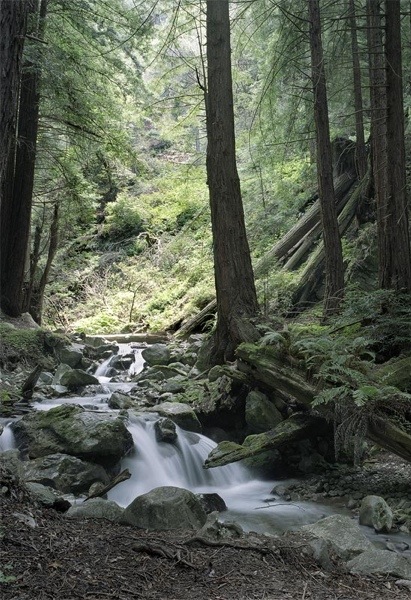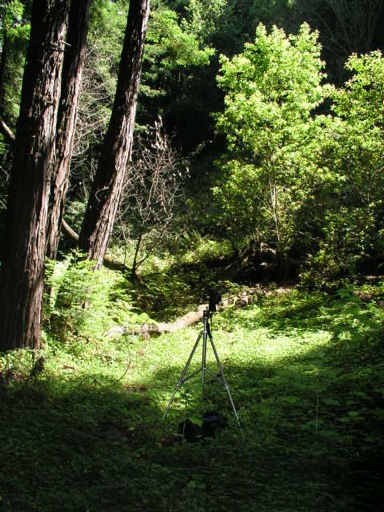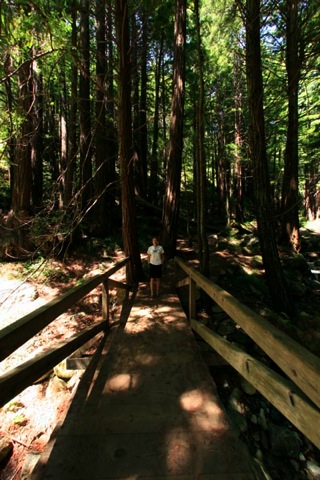The whole megillah.
There are times of the year you really do not want to be driving on Highway One in central California. This is one of them. Make it a weekend and you would probably have more fun doing your taxes. You see, for reasons known only to the drafters of the Constitution, RVs and SUVs are allowed on this narrow winding road. As the selfish idiots who drive these vehicles (imagine doing 2 mpg in an RV and having to carry your waste with you) are also incapable of reading, ‘Turnout’ means nothing to them, leaving but three or four legal (and semi-suicidal) passing areas in the 40 miles between Hearst Castle and Limekiln State Park, a trip I took yesterday. This was not helped by the fact that the road was well and truly socked in, fog being par for the course at this time of the year. The only person having fun on this road was the guy who passed me on the double yellow on his Ducati. More power to him.
So my first words to the Forest Ranger on arriving at Limekiln and handing over my $6 were “Boy, there are some bad drivers out there”. “No kidding”, he replied, “two went off the road at night just north of here last night and fell 700 feet to the ocean floor. Both died.” Let’s hope they were driving an RV – nature’s little fix for the gene pool.
Having been to Limekiln many times, the fog left me untroubled, for I knew that some 500 yards from the Pacific all would be sweetness and light. A few seconds in the warming sun and a whiff or two of scented air, and the frustrations of the trip were forgotten.
The goal was simple. I have always been mightily frustrated with my pictures here, for two reasons. First, the insane dynamic range makes preserving of detail in both highlights and shadows very difficult. Second, there is simply no way a static picture can convey the sheer magnificence of a giant redwood forest.
Here’s the sort of thing you get on 4″ x 5″ – at least the dynamic range is OK:

Limekiln. Crown Graphic 4×5, 210mm Sironar, Kodak Portra VC160
But, let’s face it, you are not there.
So after all that work to learn QTVR photography, and tons more to learn HDR, I put the whole thing together after all those tedious tests in the home I have documented here over the past few days.

Canon EOS 5D and KingPano at Limekiln State Park, CA, July 17, 2006
I took no fewer than 24 pictures per image. 6 ‘circle’ views with the vertically mounted 5D + Canon fisheye rotated about a vertical axis on the KingPano head, each ‘view’ comprised of three pictures, properly exposed, + 2 stops (actually shutter speeds) and -2 stops. Two more views, each of three images, added the zenith and nadir images.
Back home (I had much fun on the drive back trying to run a pig on a Harley with open pipes – blasting his foul noise into unspoiled nature – off the road) each set of three images was merged in Photomatix into one HDR image which was then tone mapped in the same application. All eight resulting images were then dropped into PTMac, the previously determined lens parameters applied and auto control point generation was commenced. I didn’t even bother to delete the ‘bad’ (meaning big) control points. Saved the TIFF file, into Photoshop for final Levels and Curves fine tuning, a quick check of stitching using the Panagea plug-in, and then on to CubicConverter to save the panorama with the right starting point and zoom settings. This time I used the ‘M (high)’ JPG quality setting on the 5D, meaning each source image was between 3.4 mB and 5.1 mB. For some reason the underexposed ones are larger. Whatever. No need to use RAW – the files are too large for my purposes and I get better tone mapping through HDR than RAW can provide.
You can judge how much HDR adds to dynamic range from this non-HDR extract:

And here is the QTVR HDR result of the 24 constituent images:
The young girl actually arrived on the scene when I had just finished the ‘circle’ images, so I asked her to stand as still as she could while I took three more to replace the original. As you can see, she moved slightly, but the effect is there. Photographer’s luck. You can’t have it if you don’t take pictures.
The file is some 2.5 mB in size, owing to the high quality of the JPGs used, and I have constrained the zoom range to the point where quality is not compromised on zooming in.
While taking 24 pictures to make one result sounds daunting, once you get the hang of it, assisted by auto over/under exposures and motor drive, and the click stops on the King Pano, things move along very fast. I didn’t even bother re-levelling the rig between shots, the subject being far less demanding for stitching purposes than the indoor scenes used to calibrate the equipment. A check of the time stamps on the files shows that the whole thing was done in two minutes. And do get QR heads for camera->King Pano and KingPano->tripod – the thought of all that screwing (I get enough from the IRS, thank you) in their absence is …. not good.
I hope you have enjoyed this learning exercise in QTVR HDR photography as much as I have.